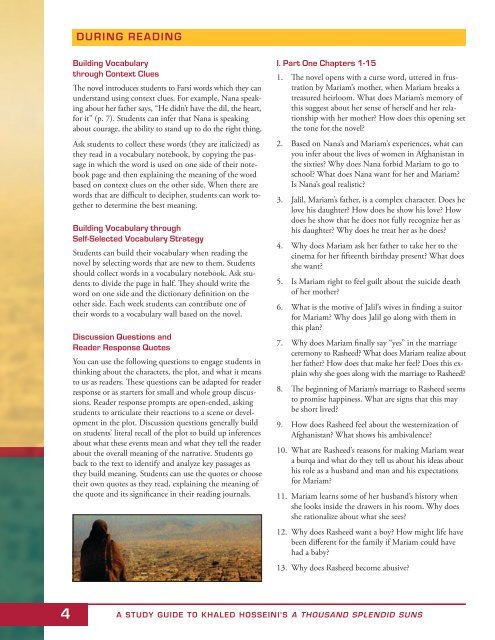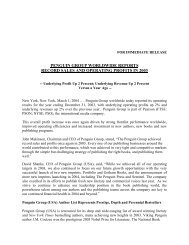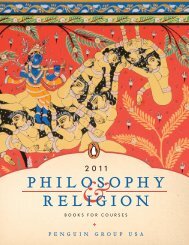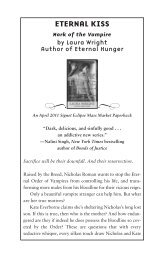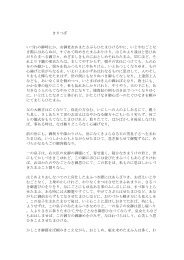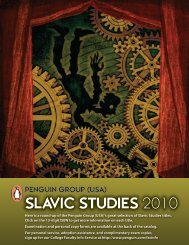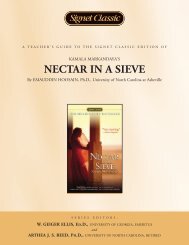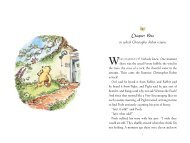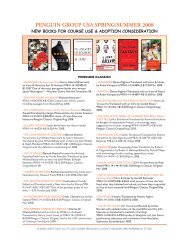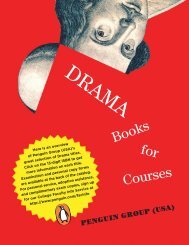KHALED HOSSEINI - Penguin Group
KHALED HOSSEINI - Penguin Group
KHALED HOSSEINI - Penguin Group
Create successful ePaper yourself
Turn your PDF publications into a flip-book with our unique Google optimized e-Paper software.
DURING READING<br />
Building Vocabulary<br />
through Context Clues<br />
The novel introduces students to Farsi words which they can<br />
understand using context clues. For example, Nana speaking<br />
about her father says, “He didn’t have the dil, the heart,<br />
for it” (p. 7). Students can infer that Nana is speaking<br />
about courage, the ability to stand up to do the right thing.<br />
Ask students to collect these words (they are italicized) as<br />
they read in a vocabulary notebook, by copying the passage<br />
in which the word is used on one side of their notebook<br />
page and then explaining the meaning of the word<br />
based on context clues on the other side. When there are<br />
words that are difficult to decipher, students can work together<br />
to determine the best meaning.<br />
Building Vocabulary through<br />
Self-Selected Vocabulary Strategy<br />
Students can build their vocabulary when reading the<br />
novel by selecting words that are new to them. Students<br />
should collect words in a vocabulary notebook. Ask students<br />
to divide the page in half. They should write the<br />
word on one side and the dictionary definition on the<br />
other side. Each week students can contribute one of<br />
their words to a vocabulary wall based on the novel.<br />
Discussion Questions and<br />
Reader Response Quotes<br />
You can use the following questions to engage students in<br />
thinking about the characters, the plot, and what it means<br />
to us as readers. These questions can be adapted for reader<br />
response or as starters for small and whole group discussions.<br />
Reader response prompts are open-ended, asking<br />
students to articulate their reactions to a scene or development<br />
in the plot. Discussion questions generally build<br />
on students’ literal recall of the plot to build up inferences<br />
about what these events mean and what they tell the reader<br />
about the overall meaning of the narrative. Students go<br />
back to the text to identify and analyze key passages as<br />
they build meaning. Students can use the quotes or choose<br />
their own quotes as they read, explaining the meaning of<br />
the quote and its significance in their reading journals.<br />
I. Part One Chapters 1-15<br />
1. The novel opens with a curse word, uttered in frustration<br />
by Mariam’s mother, when Mariam breaks a<br />
treasured heirloom. What does Mariam’s memory of<br />
this suggest about her sense of herself and her relationship<br />
with her mother? How does this opening set<br />
the tone for the novel?<br />
2. Based on Nana’s and Mariam’s experiences, what can<br />
you infer about the lives of women in Afghanistan in<br />
the sixties? Why does Nana forbid Mariam to go to<br />
school? What does Nana want for her and Mariam?<br />
Is Nana’s goal realistic?<br />
3. Jalil, Mariam’s father, is a complex character. Does he<br />
love his daughter? How does he show his love? How<br />
does he show that he does not fully recognize her as<br />
his daughter? Why does he treat her as he does?<br />
4. Why does Mariam ask her father to take her to the<br />
cinema for her fifteenth birthday present? What does<br />
she want?<br />
5. Is Mariam right to feel guilt about the suicide death<br />
of her mother?<br />
6. What is the motive of Jalil’s wives in finding a suitor<br />
for Mariam? Why does Jalil go along with them in<br />
this plan?<br />
7. Why does Mariam finally say “yes” in the marriage<br />
ceremony to Rasheed? What does Mariam realize about<br />
her father? How does that make her feel? Does this explain<br />
why she goes along with the marriage to Rasheed?<br />
8. The beginning of Mariam’s marriage to Rasheed seems<br />
to promise happiness. What are signs that this may<br />
be short lived?<br />
9. How does Rasheed feel about the westernization of<br />
Afghanistan? What shows his ambivalence?<br />
10. What are Rasheed’s reasons for making Mariam wear<br />
a burqa and what do they tell us about his ideas about<br />
his role as a husband and man and his expectations<br />
for Mariam?<br />
11. Mariam learns some of her husband’s history when<br />
she looks inside the drawers in his room. Why does<br />
she rationalize about what she sees?<br />
12. Why does Rasheed want a boy? How might life have<br />
been different for the family if Mariam could have<br />
had a baby?<br />
13. Why does Rasheed become abusive?<br />
4 A STUDY GUIDE TO <strong>KHALED</strong> <strong>HOSSEINI</strong>’S A THOUSAND SPLENDID SUNS


